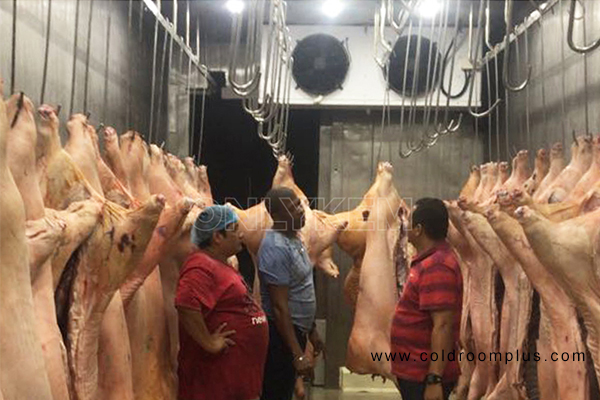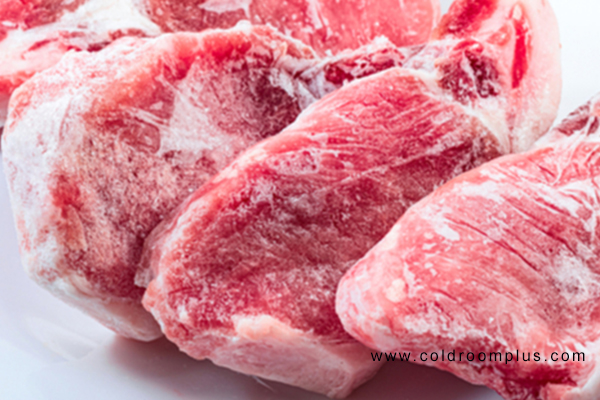Understanding the correct meat cold room procedures whether frozen or chilled, is important if you want produce that is as fresh, delicious and safe as possible.
Harmful bacteria begin to develop in raw meat from the moment an animal is slaughtered, making storage an incredibly time sensitive process. If you want or need to prolong the life of your meat for as long as possible, it’s crucial that you follow the correct safe storage procedures.
Usually the temperature dropped below -18 ℃, the food freezing rate was high, the microorganisms and enzymes basically stopped moving and growing, and the oxidation was also very slow. Therefore, the food can be stored for a longer period of time and has better frozen quality. In addition, frozen food also requires that the temperature in the storehouse be relatively stable. Excessive temperature fluctuations will cause spoilage of the food.
If meat and other related products are not stored or preserved within the right temperature, the quality and flavor of the products will diminish or get contaminated. The only way to avoid such circumstances is to preserve your meat products in cold rooms at a suitable temperature. The best temperatures to store meat are around +10°C and -1°C.
Although they are other methods of preserving meat and other related products, studies have shown that storing in cold rooms doesn’t just keep the food safe from contamination; it also retains its nutritious values. Storing meat is the most difficult food item to preserve. No wonder they are sold at expensive prices by restaurants and eateries.


Below are a few factors that you should consider when storing meat in a cold room;
● Washing the meat properly before storing in a cold room is very important It will prevent bacteria’s that can survive under cold conditions from sticking around
● Uncooked meat shouldn’t be wrapped; rather they should be hung in the freezer so that air can around circulate them. If you are using a walk-in refrigerator, the best temperature to store meat is 1°C to 3°C (34°C to 37°F)
● Insert absorbent paper beneath the meat so that you can clean up the unwanted drips and bloodstains
● Steaks, chops, and ground meat should be kept in plastic or stainless strays at the temperature of 2°C to 4°C (36°F to 39°F)
● If the meat is cooked, store them in a covered plastic or stainless steel container
Meat cold room is mainly used for the cold processing of meat carcasses such as pigs, cattle, and sheep.
1、Pre-cooling room
The freezing point of meat juice is -0.6 ~ -1.2 ℃. When the carcass temperature after slaughtering is about 35 ℃, it is sent to a cold room. The designed room temperature is about 0 ~ -2 ℃. The meat temperature is reduced to 4 ℃ in the cold room. Due to the small heat capacity and thermal conductivity of the air, increasing the air flow rate can increase the cooling rate. However, an excessively strong air flow rate cannot increase the cooling rate compared with the same period of the previous year, but it will greatly increase the dry shrinkage loss and power consumption of the meat surface. Therefore, in the cooling process, the wind speed in the cargo room of the cold room is suitable not to exceed 2m / s, and generally the above 0.5m / s is used. The air circulation times are 50 ~ 60 times / h, and the cooling time is 10 ~ 20h. The average dry body consumption is about 1.3%.
2、Cooling processing
A、The temperature is -10 ~ -15 ℃, the air velocity is 1.5 ~ 3m / s, and the cooling time is 1-4h. The average enthalpy value of the meat at this stage is about 40kj / kg, which makes the surface of the meat form a layer of ice. Not only reduces the dry consumption, but also accelerates the cooling process (the thermal conductivity of ice is 4 times that of water).
B、The cold room temperature is about -1 ℃, the air velocity is 0.5 ~ 1.5m / s, and the cooling time is 10 ~ 15h, so that the surface temperature gradually increases and the internal temperature gradually decreases, so that the temperature of the body is balanced until the thermal center temperature reaches 4 ℃. The meat cooled by this method has good color, aroma, taste and tenderness, which shortens the cooling time and reduces the dry consumption by 40% to 50%. The following picture shows the process conditions for rapid cooling of meat.
3、How long can you freeze meats for?
The first thing to understand when considering storage options is that not all meats are equal and that their storage times reflect this. It’s important to remember that the fat and water content, as well as the size of the cut, will change how long a piece of meat should be stored for in a blast freezer.
These timings are a good indication of how long regular cuts of meat will stay fresh at -18°C if storage procedures, up until this point, have been followed correctly.
Beef and lamb generally have a longer storage time because they are made up of hard fats, which are partially saturated. However younger meats, such as veal and pork, will deteriorate much faster as they have a lower level of saturated fat. Larger cuts of meat will almost always have a smaller storage time, as they take longer to blast freeze initially.
Alongside this, you should be careful never to overfill your cold storage container as this can cause meat to freeze slowly or unevenly, leaving your customers susceptible to food borne illness.
Working in the food industry, it’s important to make your food go as far as possible. Wasted food stops your business from being profitable but with the help of a blast freezer or cold room, you can keep produce fresher for longer periods of time. You can increase your profits and serve food to your customers without the worry of tainted produce.
Our meat cold room storage facilities are modern, high quality and work at optimal capacity. You can contact us for your meat cold room storage solutions. We provide the best cold rooms for your meat and other related products. Our firm offers the following services;
● Holding rooms for cattle and sheep carcass
● Cold rooms warehouses or stores for cattle and sheep products
● Product blast freezing tunnels
● Spiral freezer systems
● Design hygienic evaporator in line with the HACCP
● Building cold rooms for offals and deboning
● Designing and building low energy consuming condensers
● Control and monitoring in accordance with PLC/SCADA
● Building air conditioning systems
If you hire us, you will not only get a high-quality product, it will be sold at an affordable price. Our freezers can preserve your meat for more than 3 months without losing the nutritious values or quality
